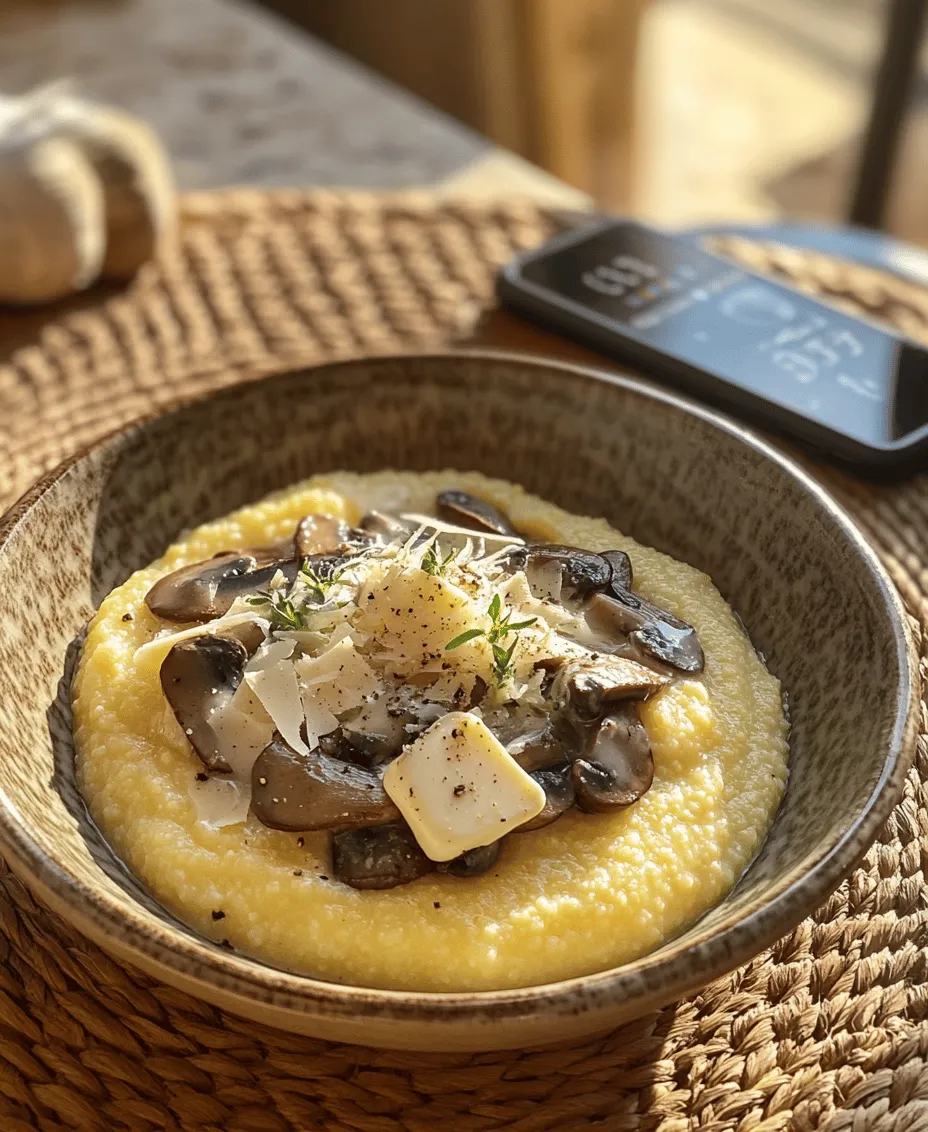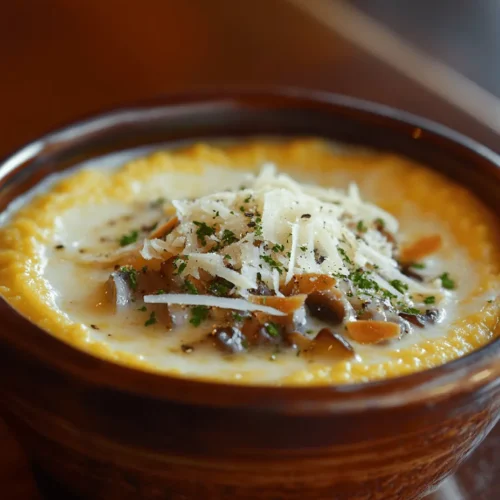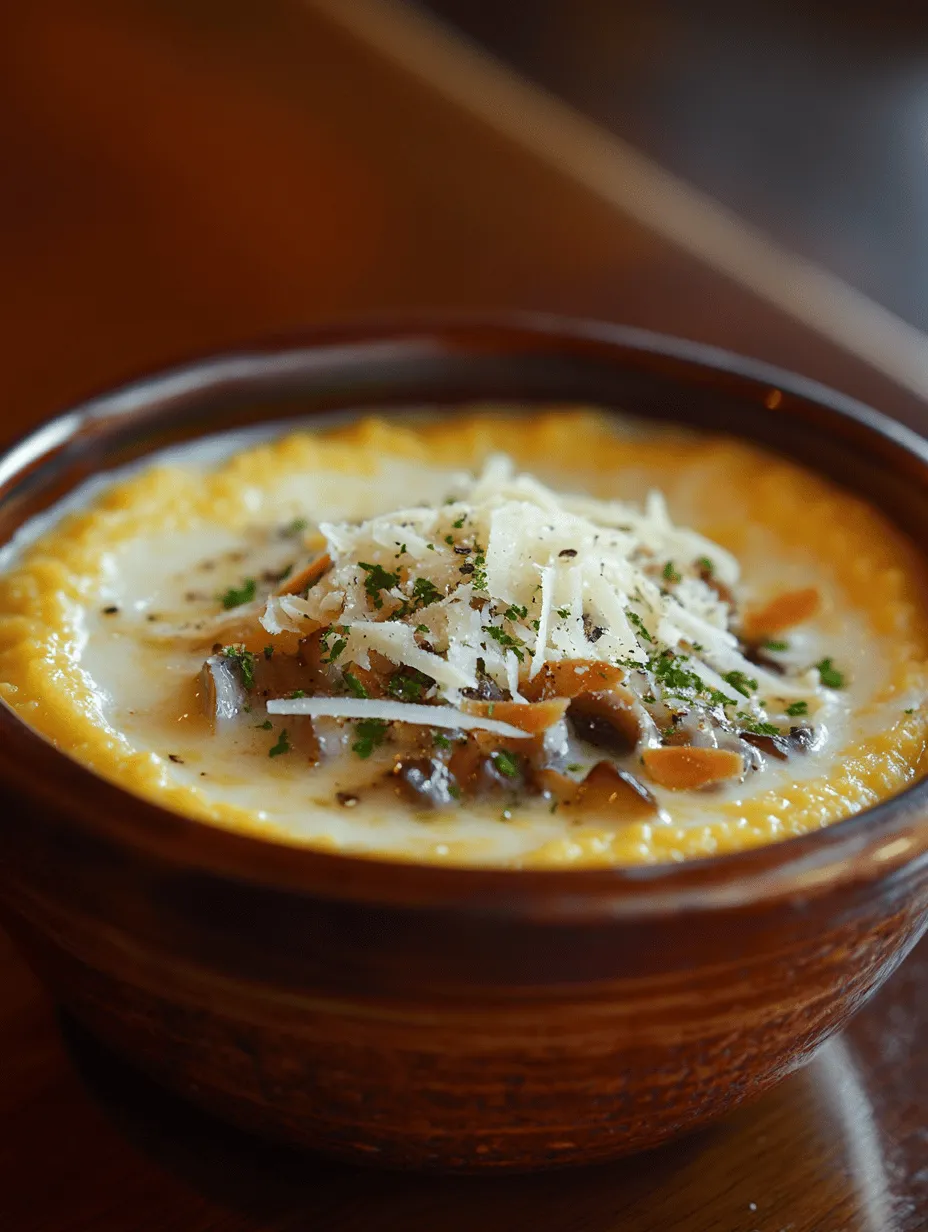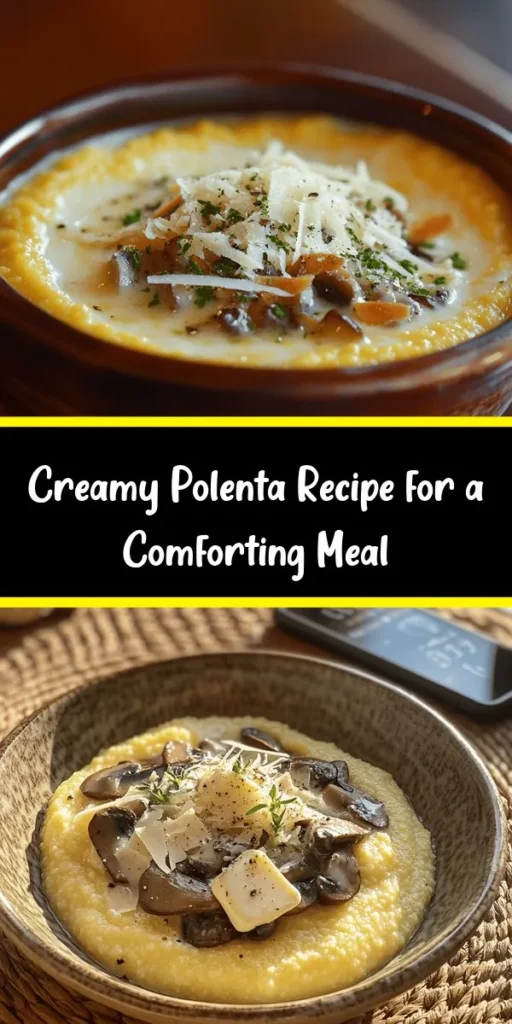Introduction
Polenta, often regarded as the unsung hero of comfort foods, is a dish that transcends boundaries and cultures. Made from ground corn, this versatile dish has roots deeply embedded in Italian cuisine, yet it has found its way into kitchens around the world. From hearty side dishes to satisfying main meals, polenta serves as a canvas for a variety of flavors and textures, appealing to both the palate and the soul.
Historically, polenta has been a staple in Italian households, especially in the northern regions where corn is abundant. It was once considered a peasant food, providing nourishment and sustenance for families who relied on simple, hearty ingredients. Over time, polenta has evolved into a beloved dish that graces the tables of fine dining establishments and home kitchens alike. Its creamy consistency and comforting nature make it a go-to choice for those seeking warmth and satisfaction in a bowl.
In this article, we will explore the art of preparing perfectly creamy polenta. Whether you are familiar with this dish or a newcomer eager to try your hand at making it, our detailed recipe and insights will guide you through the process. With the right ingredients and techniques, you’ll be able to create a polenta dish that is not only delicious but also a testament to the rich culinary heritage it represents.
Understanding Polenta
To truly appreciate polenta, it’s essential to understand what it is and how it’s made. Polenta is essentially a dish derived from ground corn, a staple ingredient that has nourished people for centuries. The corn is typically ground into various textures, from fine to coarse, which influences the final product’s taste and consistency.
There are two primary types of cornmeal used for making polenta: medium and coarse grind. Medium grind polenta cooks up to a creamier consistency, while coarse grind polenta results in a heartier texture with more substantial bite. The choice between the two often depends on personal preference and the desired outcome of the dish. Both can be delicious, but for the purpose of achieving that perfect creamy texture, medium grind polenta is recommended.
Nutritionally, polenta offers a range of benefits. It is naturally gluten-free, making it an excellent option for those with gluten sensitivities or celiac disease. Polenta is also high in carbohydrates, providing a good source of energy. Additionally, it contains fiber, which is essential for digestive health. This combination of nutritional benefits and versatility makes polenta a great addition to any diet.
Essential Ingredients for Perfectly Creamy Polenta
Creating perfect polenta requires a few essential ingredients that work harmoniously to produce a creamy, flavorful dish. Here’s a breakdown of the key components needed to achieve that luxurious texture and taste:
1. Cornmeal: When selecting cornmeal, the grind matters. Medium grind cornmeal is the best choice for creamy polenta, as it cooks smoothly and absorbs flavors well. Opt for high-quality, stone-ground cornmeal if possible, as it tends to have a richer flavor and better texture.
2. Water vs. Vegetable Broth: The liquid used to cook the polenta can greatly influence its flavor. While water is a standard choice, using vegetable broth can enhance the taste and add depth to the final dish. This is especially beneficial if you plan to serve the polenta as a base for savory toppings.
3. Unsalted Butter: Incorporating unsalted butter into the polenta is crucial for achieving that creamy consistency. Butter not only adds richness but also helps to smooth out the texture, making the polenta luxuriously velvety.
4. Parmesan Cheese: A generous sprinkle of grated Parmesan cheese elevates the flavor of the polenta, imparting a nutty, savory profile that complements the dish beautifully. For a vegan alternative, nutritional yeast can be used to achieve a similar flavor.
5. Salt and Black Pepper: These staples are essential for balancing the flavors in your polenta. Proper seasoning enhances the overall taste and ensures that the dish is flavorful without being overpowering.
6. Optional Toppings: While polenta can be enjoyed on its own, adding toppings can elevate the dish to new heights. Consider sautéed mushrooms, fresh herbs, roasted vegetables, or a drizzle of olive oil to enhance the flavor and presentation. These additions not only provide visual appeal but also introduce a variety of textures and tastes.
Step-by-Step Instructions to Prepare Creamy Polenta
Now that you have a solid understanding of polenta and its essential ingredients, let’s delve into the step-by-step process of preparing perfectly creamy polenta. It’s a straightforward process, but patience and attention to detail are key to achieving the ideal consistency.
Boiling the Liquid
Start by choosing your preferred liquid—water or vegetable broth. If using broth, opt for a low-sodium version to control the saltiness of the final dish. In a large saucepan, bring about 4 cups of your chosen liquid to a gentle boil over medium-high heat. As the liquid heats, you can add a pinch of salt to enhance the flavor.
Gradually Incorporating Cornmeal
Once the liquid reaches a rolling boil, it’s time to add the cornmeal. To prevent lumps from forming, it’s crucial to sprinkle the cornmeal into the boiling liquid gradually while whisking continuously. This technique ensures that the cornmeal incorporates smoothly, leading to a creamy texture. If you pour the cornmeal in all at once, you risk creating clumps that will be difficult to break down.
Cooking Time and Stirring
After incorporating the cornmeal, reduce the heat to low and continue to stir frequently. The polenta will begin to thicken, and this is where patience is vital. Allow the polenta to cook for approximately 30 to 40 minutes, stirring often to prevent sticking and ensure even cooking. As the polenta cooks, it will absorb the liquid, becoming thicker and creamier.
To check for doneness, taste the polenta periodically. It should be tender and smooth, with no gritty texture from the cornmeal. If you find that the polenta is too thick, you can stir in additional liquid (water or broth) to achieve your desired consistency. Once the polenta is cooked to perfection, remove it from the heat and stir in the unsalted butter and grated Parmesan cheese. This final step adds richness and flavor, making your polenta irresistibly creamy.
With these steps, you’re well on your way to creating a delightful dish of creamy polenta that can be enjoyed in a multitude of ways. Stay tuned for more insights and tips on serving and elevating this classic comfort food.

Final Touches: Incorporating Butter and Cheese for Creaminess
Once your polenta reaches that perfect creamy consistency, it’s time to elevate it with the final touches of butter and cheese. This step is crucial for achieving the ultimate richness and flavor. Start by stirring in a generous knob of unsalted butter and freshly grated cheese, such as Parmigiano-Reggiano or Pecorino Romano. The heat from the polenta will melt these ingredients, resulting in a velvety texture that is hard to resist.
Begin with about 2 tablespoons of butter and 1/2 cup of cheese. You can adjust these amounts to suit your taste preferences. For a sharper flavor, consider using aged cheese, or for creaminess, opt for a softer variety like mascarpone or cream cheese. Stir these in thoroughly until they’re fully incorporated, and you’ll notice the polenta becomes even creamier and more indulgent.
Tips for Achieving the Ideal Texture
The texture of your polenta can vary significantly based on cooking time and technique, so it’s vital to monitor the process closely. If you prefer a creamy polenta, aim for a shorter cooking time of about 30-40 minutes, stirring frequently until the grains are tender. For a thicker polenta, increase the cooking time to 45-60 minutes, allowing it to absorb more water and develop a firmer consistency.
Stirring is essential; it prevents the polenta from clumping and sticking to the bottom of the pot. Use a wooden spoon or a silicone spatula to stir regularly. However, if you’re looking for a super-smooth texture, consider employing a whisk. A whisk can help break up any lumps more effectively than a spoon, ensuring a silky finish.
Serving Suggestions and Pairings
Polenta is incredibly versatile, making it suitable for both main dishes and sides. Here are some ideas to inspire your serving options:
1. As a Main Dish or Side: Serve creamy polenta as a hearty base for stews, braises, or roasted meats. It can also stand alone as a vegetarian main dish, topped with sautéed greens or a rich tomato sauce.
2. Complementing Toppings:
– Sautéed Mushrooms: Enhance the umami flavor by adding a mix of sautéed mushrooms. Use a combination like shiitake and cremini for depth and flavor.
– Fresh Herbs: Add a sprinkle of fresh herbs, such as parsley, basil, or chives, just before serving. This will introduce brightness and a pop of color to your dish.
– Roasted Vegetables: Pair your polenta with a medley of roasted seasonal vegetables for added nutrition and taste. Root vegetables like carrots and sweet potatoes, or even Brussels sprouts, work beautifully.
3. Creative Incorporations: Explore different meal variations using polenta:
– Breakfast Bowls: Top your creamy polenta with a poached egg, avocado, and hot sauce for a nourishing breakfast.
– Layered Dishes: Use polenta as a layer in casseroles or lasagna-like creations, alternating it with vegetables and cheese for a comforting dish.
Storing and Reheating Polenta
If you find yourself with leftover polenta, don’t worry—there are plenty of ways to store and repurpose it. Here are best practices to keep in mind:
1. Storing: Allow the polenta to cool completely before transferring it to an airtight container. It can be stored in the refrigerator for up to 5 days. For longer storage, consider freezing it in portions. Just make sure to wrap it tightly in plastic wrap or foil, followed by a layer of freezer-safe bag.
2. Reheating: To reheat polenta without losing its creamy texture, add a splash of water or broth to the polenta in a saucepan, then gently warm it over low heat while stirring. This will help loosen it up and bring back its original consistency. Alternatively, you can microwave it in short intervals, stirring in between, but be cautious not to overcook it.
3. Creative Uses for Leftover Polenta: Don’t let leftover polenta go to waste! You can slice it into shapes and pan-fry or bake until crispy to create polenta fritters. Alternatively, use it as a base for a baked dish, layering it with cheese and vegetables for a delicious casserole.
Cultural Variations of Polenta
Polenta is a dish with deep roots in various cuisines around the world. While it is most commonly associated with Italian cuisine, where it is often served as a comforting side dish or a base for sauces, its versatility extends far beyond that:
– Italian Polenta: In Italy, polenta is a staple, particularly in northern regions. It can be served soft and creamy or allowed to cool and solidify, then sliced and grilled or fried. Traditional dishes include Polenta Taragna, made with buckwheat flour, and Polenta concia, enriched with cheese and butter.
– Brazilian Polenta: In Brazil, polenta (or “polenta de milho”) is often prepared with cornmeal and served as a side for hearty stews or with grilled meats. It can also be found in a fried form, served as a snack or appetizer.
– Polenta in Other Cultures: Polenta also has variations in other South American countries, where it may be known as “arepitas” or “arepas.” These dishes highlight the adaptability of cornmeal in various culinary traditions.
Understanding these cultural variations opens up exciting opportunities to experiment with polenta in your cooking, incorporating different spices and flavors from around the world.
Conclusion
Creamy polenta is a simple yet versatile dish that can elevate any meal. Its adaptability allows you to explore a myriad of flavors and toppings, making it a perfect canvas for culinary creativity. Whether you serve it as a comforting side, a hearty main dish, or even a breakfast bowl, polenta offers a delightful experience for every palate.
We encourage you to experiment with flavors, whether through rich cheeses, vibrant herbs, or earthy vegetables. The joy of creating and enjoying homemade polenta lies in its ability to bring together various tastes and textures, making every meal unique. So go ahead, embrace the simplicity of polenta, and let your culinary imagination run wild!



